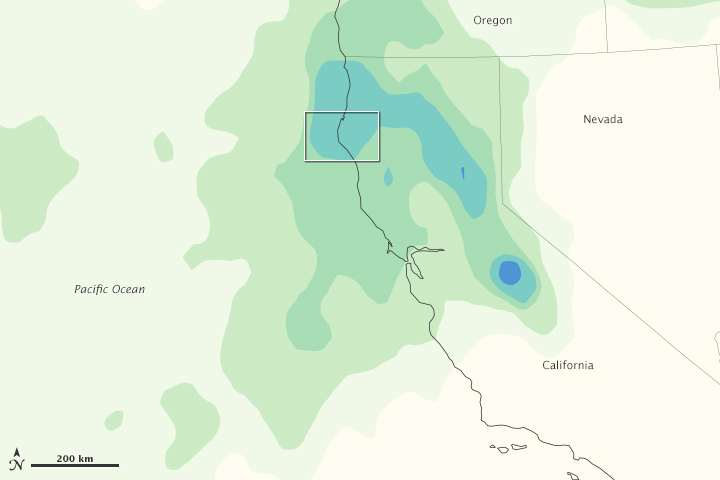


After a series of rainstorms drenched northern California in late November and early December 2012, sediment-laden water was coursing down the Eel River toward the Pacific Ocean. The Moderate Resolution Imaging Spectroradiometer (MODIS) on NASA’s Aqua satellite acquired this natural-color image on December 9, 2012.
The Eel River drains about 3,680 square miles (9,530 square kilometers) of land, making it the third largest watershed in California; only the San Joaquin and Salinas rivers drain larger areas. The 200-mile (300-kilometer) river flows south to north in a rugged part of the California Coast Ranges, originating in northeastern Mendocino County and entering the Pacific in Humboldt County, near Eureka. San Francisco is about 200 miles to the south.
A number of large storms blew through northern California within a few weeks, bringing heavy rain to both inland and coastal California. Some of the largest storms passed between November 26 and December 2. The lower image shows where the rainfall was most intense during that period. It is based on data from the Multisatellite Precipitation Analysis (MPA) produced at NASA’s Goddard Space Flight Center. The MPA estimates rainfall by combining measurements from many satellites and calibrating them against rainfall measurements from the Tropical Rainfall Measuring Mission (TRMM) satellite.
The heaviest rainfall — more than 250 millimeters (10 inches) — appears in blue. The lightest — less than 50 millimeters (2 inches) — is light green. Trace amounts of rain are shown with pale yellow. The heaviest rains were concentrated along the northern California coast and in part of Yosemite National Park. An “atmospheric river” that stretched into the central Pacific Ocean sent the stream of moisture-laden air masses toward the Pacific Northwest.
The surge of rainfall, combined with normal geological processes, put unusually high loads of sediment into the Eel’s waters. The river runs through shale and sandstone rocks that are easily worn away, or eroded, by water running over them. The river also flows through many steep valleys that are prone to landslides, allowing large amounts of sediment to be dumped directly into the streams that feed the river.
Overall, northern California escaped highly destructive floods, but many rivers and creeks swelled to flood stage, temporarily closing some roads and highways.
NASA image courtesy Jeff Schmaltz, LANCE MODIS Rapid Response. Caption by Adam Voiland.